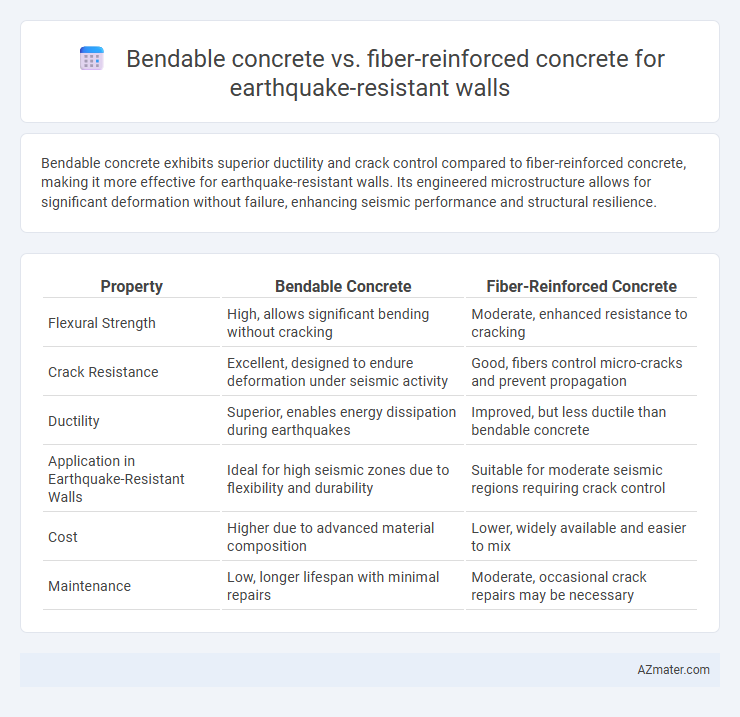Bendable concrete exhibits superior ductility and crack control compared to fiber-reinforced concrete, making it more effective for earthquake-resistant walls. Its engineered microstructure allows for significant deformation without failure, enhancing seismic performance and structural resilience.
Table of Comparison
| Property | Bendable Concrete | Fiber-Reinforced Concrete |
|---|---|---|
| Flexural Strength | High, allows significant bending without cracking | Moderate, enhanced resistance to cracking |
| Crack Resistance | Excellent, designed to endure deformation under seismic activity | Good, fibers control micro-cracks and prevent propagation |
| Ductility | Superior, enables energy dissipation during earthquakes | Improved, but less ductile than bendable concrete |
| Application in Earthquake-Resistant Walls | Ideal for high seismic zones due to flexibility and durability | Suitable for moderate seismic regions requiring crack control |
| Cost | Higher due to advanced material composition | Lower, widely available and easier to mix |
| Maintenance | Low, longer lifespan with minimal repairs | Moderate, occasional crack repairs may be necessary |
Introduction to Earthquake-Resistant Wall Materials
Earthquake-resistant wall materials must combine strength, flexibility, and durability to withstand seismic forces. Bendable concrete offers high ductility and crack resistance through engineered tensile strain capacity, allowing walls to deform without failure during earthquakes. Fiber-reinforced concrete enhances toughness and energy absorption by integrating fibers such as steel or synthetic materials, improving the structural integrity and resilience of walls under seismic loads.
What is Bendable Concrete?
Bendable concrete, also known as strain-hardening cementitious composite (SHCC), is designed to withstand tensile strain and deformation without cracking, making it ideal for earthquake-resistant walls. Unlike conventional fiber-reinforced concrete (FRC), which primarily controls crack width and improves toughness, bendable concrete exhibits multiple fine cracks and maintains structural integrity under flexural stress. This enhanced ductility and strain capacity significantly improve earthquake resilience by absorbing seismic energy and preventing sudden structural failure.
Overview of Fiber-Reinforced Concrete
Fiber-reinforced concrete (FRC) incorporates discrete fibers such as steel, glass, or synthetic materials within the concrete matrix, enhancing tensile strength and crack resistance critical for earthquake-resistant walls. FRC improves ductility and energy absorption capacity, allowing walls to better withstand seismic forces by controlling crack propagation and delaying structural failure. Its adaptability for various fiber types and dosages makes FRC a versatile option compared to bendable concrete, offering reinforced durability without compromising structural integrity.
Key Material Properties: Flexibility and Strength
Bendable concrete exhibits enhanced flexibility and tensile strain capacity, allowing it to absorb and dissipate earthquake energy without cracking, making it highly suitable for earthquake-resistant walls. Fiber-reinforced concrete combines conventional concrete with synthetic or steel fibers, significantly increasing tensile strength, toughness, and crack control to improve structural resilience under seismic loads. Both materials optimize seismic performance through increased flexibility and strength, but bendable concrete offers superior deformation capacity while fiber-reinforced concrete enhances load-bearing and impact resistance.
Seismic Performance Comparison
Bendable concrete exhibits superior seismic performance compared to fiber-reinforced concrete due to its high tensile ductility and crack control capabilities, allowing walls to flex and absorb earthquake energy without significant damage. Fiber-reinforced concrete enhances toughness and impact resistance but often falls short in preventing brittle failure during high-intensity seismic events. Studies indicate that bendable concrete reduces crack widths and maintains structural integrity under cyclic loading more effectively than traditional fiber-reinforced composites, making it a preferred choice for earthquake-resistant walls.
Installation and Construction Techniques
Bendable concrete, featuring engineered microfibers and polymer additives, allows for flexible formwork and easier layering during installation, reducing cracking risks in earthquake-resistant walls. Fiber-reinforced concrete, embedded with steel or synthetic fibers, requires more precise mixing and placement to ensure uniform fiber distribution, demanding skilled labor and specialized equipment. Both materials benefit from controlled curing processes, but bendable concrete offers simpler on-site adjustments due to its enhanced ductility and lower shrinkage rates.
Durability and Longevity in Seismic Zones
Bendable concrete exhibits superior crack control and energy dissipation due to its high ductility, making it highly durable under repetitive seismic stress and extending the lifespan of earthquake-resistant walls. Fiber-reinforced concrete enhances toughness and prevents crack propagation, but its durability may diminish over time as fibers degrade or corrode in harsh seismic environments. In seismic zones, bendable concrete provides prolonged structural integrity and reduced maintenance needs compared to fiber-reinforced concrete, contributing to more resilient and long-lasting earthquake-resistant walls.
Cost Analysis: Bendable vs. Fiber-Reinforced Concrete
Bendable concrete typically incurs higher initial costs due to the specialized materials and manufacturing processes required, but offers superior ductility and crack control for earthquake-resistant walls. Fiber-reinforced concrete provides a more cost-effective solution with improved tensile strength and energy absorption at a lower price point. When evaluating long-term expenses, bendable concrete may reduce repair and maintenance costs, potentially offsetting its upfront investment in seismic applications.
Sustainability and Environmental Impact
Bendable concrete, also known as Engineered Cementitious Composite (ECC), offers enhanced durability and crack control, reducing the need for frequent repairs and lowering material consumption in earthquake-resistant walls, which contributes positively to sustainability. Fiber-reinforced concrete (FRC) integrates synthetic or steel fibers to improve tensile strength and toughness, but its environmental impact depends on fiber type, with natural fibers presenting a greener alternative to synthetic ones. Both materials contribute to extending structural lifespan, yet bendable concrete's superior ductility and repair efficiency often result in a lower overall carbon footprint and reduced resource use in seismic applications.
Choosing the Right Concrete for Earthquake-Resistant Walls
Bendable concrete offers superior ductility and crack resistance by incorporating engineered microfibers and special polymers, enhancing seismic energy dissipation for earthquake-resistant walls. Fiber-reinforced concrete improves tensile strength and controls crack propagation through embedded steel or synthetic fibers, providing reliable structural support under seismic stress. Selecting the ideal concrete depends on specific seismic zone requirements, desired wall flexibility, and long-term durability considerations to ensure optimal earthquake resilience.

Infographic: Bendable concrete vs Fiber-reinforced concrete for Earthquake-resistant wall
 azmater.com
azmater.com